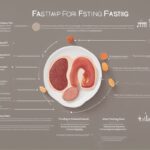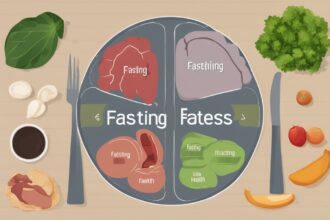Hey there, fellow health enthusiasts! If you’ve been curious about fasting and its impact on your body, you’re in for a treat today. In this comprehensive fasting guide, we’re diving deep into how fasting can influence one of the most vital organs in your body—your liver. Often called the body’s detox powerhouse, the liver plays a critical role in metabolism, fat processing, and toxin removal. But can fasting really support liver health, or is it just another wellness trend? Let’s unpack the science, benefits, and practical tips to help you make informed decisions about incorporating fasting into your lifestyle. Whether you’re a seasoned faster or just starting out, this post will give you the insights you need to optimize your liver health through fasting.
What Is Fasting, and How Does It Work?
Fasting, at its core, is the voluntary abstention from food and sometimes drink for a specific period. It’s not a new concept—humans have practiced fasting for centuries for spiritual, cultural, and health reasons. Today, it’s gaining traction as a tool for weight management, metabolic health, and even longevity. Popular methods like intermittent fasting (IF), time-restricted eating, and prolonged fasting are all part of the broader fasting guide that many follow. But how does fasting tie into liver health? When you fast, your body shifts from using glucose as its primary energy source to burning stored fats through a process called ketosis. This metabolic switch can have profound effects on the liver, which is central to fat metabolism and energy regulation (Mattson et al., 2017).
The Liver’s Role in Your Body and Why It Matters
Your liver is a multitasking marvel. It processes nutrients, filters toxins, produces bile for fat digestion, and regulates blood sugar levels. However, modern lifestyles—think high-sugar diets, excessive alcohol, and sedentary habits—can overburden the liver, leading to conditions like fatty liver disease, inflammation, or even cirrhosis. Non-alcoholic fatty liver disease (NAFLD), for instance, affects up to 25% of the global population and is often linked to obesity and poor dietary choices (Younossi et al., 2016). This is where fasting comes in as a potential ally. By giving your digestive system a break, fasting may help reduce the liver’s workload, allowing it to focus on repair and detoxification processes. As part of a well-rounded fasting guide, understanding your liver’s needs can help you tailor your fasting approach for maximum benefit.
Scientific Insights: How Fasting Benefits Liver Health
Let’s get into the nitty-gritty of what science says about fasting and liver health. Research suggests that fasting can reduce liver fat accumulation, a key factor in NAFLD. During fasting, the body taps into fat stores for energy, which can decrease fat buildup in the liver over time (Patterson & Sears, 2017). Additionally, fasting promotes autophagy—a cellular “clean-up” process where damaged cells are recycled—which may help protect liver cells from oxidative stress and inflammation (Levine & Kroemer, 2019). Studies on intermittent fasting have also shown improvements in insulin sensitivity, a critical factor for liver health since insulin resistance often contributes to fat storage in the liver (Halberg et al., 2005). While the research is promising, it’s worth noting that most studies are still in early stages or conducted on animals, so human results may vary. Still, these findings make a compelling case for including fasting in your health toolkit.
Potential Risks of Fasting for Liver Health
While fasting offers potential benefits, it’s not a one-size-fits-all solution. For some, especially those with pre-existing liver conditions like cirrhosis or hepatitis, fasting could pose risks. Prolonged fasting without proper preparation might stress the body, leading to nutrient deficiencies or worsening liver function if not monitored (Longo & Mattson, 2014). It’s also crucial to avoid “yo-yo” fasting—where you fast intensely then binge on unhealthy foods—since this can spike blood sugar and fat levels, negating any benefits. As your go-to fasting guide, I recommend consulting a healthcare provider before starting any fasting regimen, especially if you have liver concerns or are on medication. Balance is key, and fasting should complement, not replace, a healthy diet and lifestyle.
Practical Tips for Fasting to Support Liver Health
Ready to give fasting a try for better liver health? Here are some actionable tips to help you start safely and effectively. These strategies are designed to align with a beginner-friendly fasting guide while focusing on liver support.
- Start Slow with Intermittent Fasting: If you’re new to fasting, try a 16:8 approach—fast for 16 hours and eat during an 8-hour window. This gives your liver a break without overwhelming your system.
- Hydrate Well: During fasting periods, drink plenty of water to support detoxification processes in the liver. Herbal teas without sugar are also a great option.
- Focus on Nutrient-Dense Foods: When breaking your fast, prioritize liver-friendly foods like leafy greens, berries, and healthy fats from avocados or nuts to reduce stress on the organ.
- Avoid Overeating Post-Fast: Resist the urge to overindulge after fasting. Small, balanced meals help maintain stable blood sugar and prevent fat buildup in the liver.
Foods and Habits to Pair with Fasting for Optimal Liver Function
Fasting alone isn’t a magic bullet for liver health—it works best when paired with supportive habits and nutrition. As part of this fasting guide, let’s explore ways to enhance your results by nurturing your liver outside of fasting windows.
- Incorporate Antioxidants: Foods like turmeric, green tea, and cruciferous vegetables (broccoli, kale) are rich in antioxidants that combat liver inflammation.
- Limit Processed Sugars and Alcohol: These can strain the liver, so cut back during eating windows to maximize fasting benefits.
- Exercise Lightly: Gentle activities like walking or yoga during fasting can boost circulation and support liver detox without overtaxing your body.
- Get Enough Sleep: Poor sleep disrupts metabolic health, so aim for 7–9 hours nightly to aid liver repair processes.
- Monitor Portion Sizes: Even healthy foods in excess can burden the liver, so practice mindful eating when breaking your fast.
By combining these habits with a structured fasting plan, you’re setting the stage for long-term liver wellness. Remember, consistency matters more than perfection, so take it one step at a time.
In wrapping up this fasting guide, it’s clear that fasting holds exciting potential for supporting liver health, from reducing fat accumulation to enhancing cellular repair. The science, while still evolving, points to benefits like improved insulin sensitivity and decreased inflammation—key factors for a healthy liver. However, fasting isn’t without its challenges, and it’s crucial to approach it thoughtfully, especially if you have existing health conditions. By starting slow, staying hydrated, and pairing fasting with liver-friendly foods and habits, you can harness its power safely. I hope this deep dive has inspired you to explore fasting as part of your wellness journey. Have you tried fasting for liver health, or are you just getting started? Drop your thoughts or questions below—I’d love to hear from you!
References
- Halberg, N., Henriksen, M., Söderhamn, N., Stallknecht, B., Ploug, T., Schjerling, P., & Dela, F. (2005). Effect of intermittent fasting and refeeding on insulin action in healthy men. Journal of Applied Physiology, 99(6), 2128–2136.
- Levine, B., & Kroemer, G. (2019). Biological functions of autophagy genes: A disease perspective. Cell, 176(1-2), 11–42.
- Cell Metabolism, 19(2), 181–192.
- Mattson, M. P., Longo, V. D., & Harvie, M. (2017). Impact of intermittent fasting on health and disease processes. Ageing Research Reviews, 39, 46–58.
- Patterson, R. E., & Sears, D. D. (2017). Metabolic effects of intermittent fasting. Annual Review of Nutrition, 37, 371–393.
- Younossi, Z. M., Koenig, A. B., Abdelatif, D., Fazel, Y., Henry, L., & Wymer, M. (2016). Global epidemiology of nonalcoholic fatty liver disease—Meta-analytic assessment of prevalence, incidence, and outcomes. Hepatology, 64(1), 73–84.






